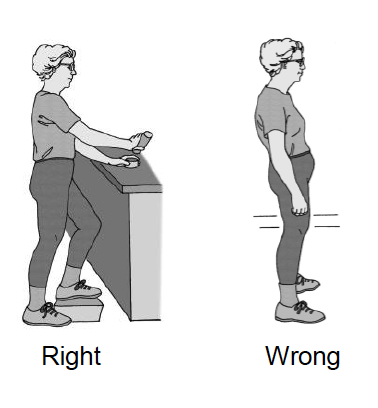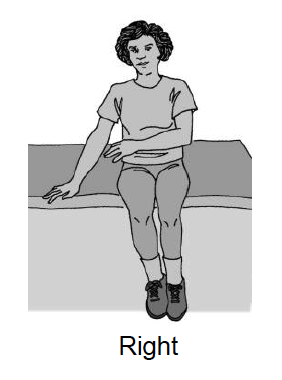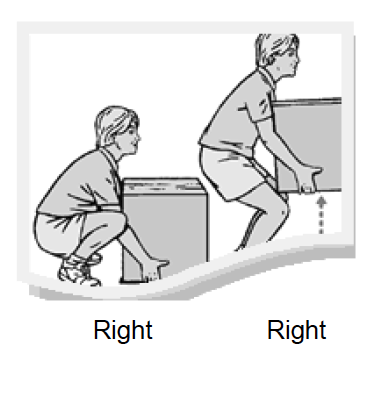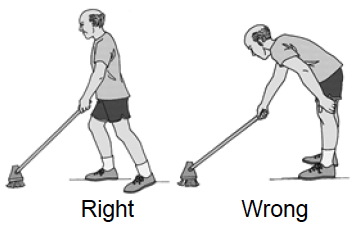Keeping Good Posture, Body Mechanics and Alignment
Good posture and proper body mechanics are important throughout your life, especially if you have osteoporosis. “Body mechanics” refers to how you move throughout the day. Knowing how to move, sit and stand properly can help you stay active and prevent broken bones and disability. Keeping good posture can also help to limit the amount of kyphosis, or forward curve of the upper back, that can result from broken bones in the spine.
One of the most important things about body mechanics and posture is alignment. Proper alignment of the body puts less stress on the spine and helps you have good posture. Alignment refers to how the head, shoulders, spine, hips, knees and ankles relate and line up with each other. To keep proper alignment, avoid the following positions or movements:
Having a slumped, head-forward posture
Bending forward from the waist with straight legs
Twisting or bending the torso (trunk) to an extreme
Twisting the torso (trunk) and bending forward when doing activities such as coughing, sneezing, vacuuming or lifting
Anything that requires you to reach far. An example is reaching up for items on high shelves when you could lose your balance and fall
Strenuous overhead lifts or carrying packages that are too heavy
Some exercises can do more harm than good. If you have osteoporosis or have broken bones in the spine, you should avoid exercises that involve bending over from the waist. Some examples of movements you should NOT do include toe touches, abdominal crunches and sit-ups (see images below).
In addition to these movements, many exercises and activities such as yoga, Pilates, tennis and golf may need to be avoided or adjusted because they often involve twisting and bending motions. Bending forward during routine activities also puts stress on the spine and can increase the chance of breaking a bone in the spine. Since bending forward puts strain on the spine, it’s safer if you’re able to keep your back flat. In the following pages we will discuss how you can keep good posture, body mechanics and alignment when you perform your daily activities.
Sitting
When sitting in a chair, try to keep your hips and knees at the same level. Place your feet flat on the floor. Keep a comfortable posture. You should have a natural inward curve to your lower back and a tall, upright upper back.
When tying your shoes or drying your feet, sit in a chair. Place one foot on a footstool, box or on your other leg. Lean forward at the hips to tie or dry. Do not bend over or slouch through your upper back. Keep the natural inward curve of your lower back and a straight upper back.
Use a footstool or footrest when seated for long periods of time.
When sitting in bucket seats or soft couches or chairs, use a rolled up towel or pillow to support your lower back.
When sitting at a desk, prop up a clipboard so it slants toward you, like a drafting table.
When reading, do not lean or slump over. Set your reading material on a desk, table or on pillows on your lap.
When standing up from a chair, move your hips forward to the front of the chair, and use your leg muscles to lift yourself up.
When driving, use the head rest.
Standing
Keep your head high, chin in, shoulder blades slightly pinched together.
Maintain the natural inward curve of your lower back as you flatten your abdomen (tummy) by gently pulling it in.
Point your feet straight ahead with your knees facing forward.
While standing in one place for more than a few minutes, put one foot up on a stool or in an open cabinet (if in kitchen). Switch to the other foot every so often. You’ll find this much less tiring for your back and legs.
Walking
Keep your head high, chin in, shoulder blades slightly pinched together.
Keep your feet pointed straight ahead, not to one side (note arrows).
Your knees should face forward. Keep them slightly bent.
Avoid letting your knees lock as you bring your weight over your feet.
Wear rubber or other non-slip soles when walking, and land lightly on your foot.
Don’t wear loose slip-on shoes or slippers.
Climbing Stairs
Use the stairs for exercise and to help maintain your bone density, but only if your healthcare provider says it’s safe for you. Build up gradually with this exercise.
Keep your head high, chin in, shoulder blades slightly pinched together and abdomen (tummy) gently pulled in.
Keep your feet pointed straight ahead, not to one side. Your knees should face forward. Keep your knees slightly bent.
Instead of putting one foot directly in front of the other, keep your feet a few inches apart, lined up under the hip on the same side.
For safety, hold the rail while going up and down but try to avoid pulling yourself up by the railing. Be especially cautious going downstairs to avoid a serious fall.
Getting Into and Out of Bed
A. Getting Into Bed
First, sit down on the side of the bed. Lean toward the head of the bed while supporting your body with both hands.
Then lie down on your side, bringing both feet up onto the bed at the same time.
Keep your knees bent and arms in front of you. Then roll onto your back in one motion. Pull your abdomen (tummy) in as you roll to support your back and to help prevent twisting.
Keep nose, knees and toes pointing in the same direction. Do not lift your head and upper back to move in bed. This puts a great deal of strain on your spine and could cause breaks in the spine.
B. Lying Down and Getting Out of Bed
When lying on your side in bed, use one pillow between your knees and one under your head to keep your spine aligned and increase your comfort.
When lying on your back in bed, use one or two pillows under your knees and one under your head.
Try to avoid using extra pillows to prop your head and upper back since this will put you into a rounded upper back position. But, if you have a rounded upper back posture with a forward head, you may need two pillows to support your neck comfortably.
When getting out of bed, reverse the steps you took to get in bed (above):
Keep both arms in front of you.
Pull your abdomen (tummy) in and breathe as you roll onto your side.
Keep your abdomen (tummy) pulled in and use your hand to raise your upper body as you carefully place your legs over the side of the bed in one motion.
Sit on the edge of the bed for a moment or two before you stand up.
When on your back, never lift your head and upper back to sit up in bed or get out of bed.
Lifting and Carrying
Don’t lift or carry objects, packages or babies weighing more than 10 pounds. If you’re unsure about how much you can lift, check with your healthcare provider.
If you are picking up a heavy object, never bend over so that your back is parallel to the ground. This places a lot of strain on your back.
To lift an object off the floor, first kneel on one knee. Place one hand on a table or stable chair for support if you need it.
Bring the object close to your body at waist level. Gently pull your abdomen (tummy) in to support your back and breathe out when you are lifting an object or straightening up. Do not hold your breath. Stand using your leg and thigh muscles.
When carrying groceries, request that your bags be packed lightly. Divide heavy items into separate bags. Hold bags close to your body. Balance the load by carrying the same amount in each hand.
When unpacking, place bags on a chair or table rather than on a high counter or floor. This prevents extra lifting and twisting of the spine.
Instead of carrying a heavy pocketbook or purse, consider a fanny pack.
Pushing and Pulling
When you vacuum, rake, sweep or mop, keep your feet apart with one foot in front of the other. Face your work directly to keep from twisting your back.
Shift your weight from foot-to-foot in a rocking movement. With knees bent and shoulder blades pinched together, move forward and back, or from side to side rhythmically. Do not bend forward from the waist.
Coughing and Sneezing
Support your back with one hand whenever you cough or sneeze.
Place your hand behind your back or on your thigh. This protects the spine from damage caused by a sudden bend forward.
Bending and Turning
Keep your feet flat and about shoulder-width apart from one another.
Let both upper arms touch your ribs on the sides, unless you’re using one hand for support.
As you bend, keep back upright and straight and shoulder blades pinched together.
Bend only at the knees and hips. Do not bend over at the waist since this will put your upper back into a rounded position which can cause broken bones in the spine.
Even when standing to brush your teeth or wash dishes, try not to bend over at the waist, but rather bend at the knees and hips while keeping your back straight.
When changing direction, move your feet with your body. Do not twist the spine. Pivot on your heels or toes with your knees slightly bent. Keep nose, knees, and toes pointing in the same direction.












